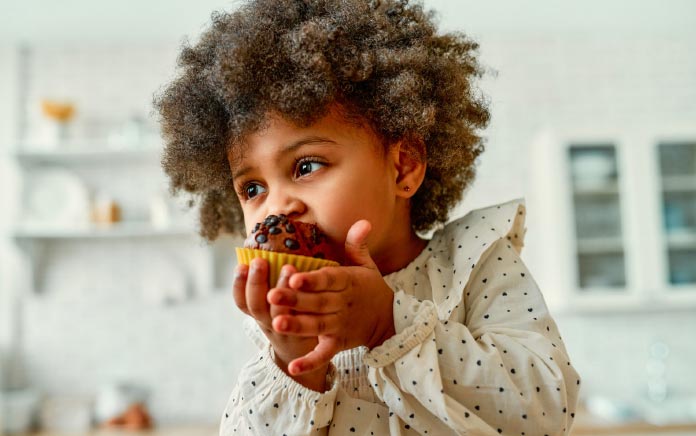Meal time can be tough with kids, if it’s unfamiliar to them. Ouiam El Hassani shares her tips on getting your child to try new food.
We’ve all been there: You’ve just spent a good 30 minutes creating a meal you think your kiddo will love and devour. But when you set it on the table, your child turns up their nose, declaring they won’t eat it, have never liked it, and will definitely not be trying it tonight. The dinner table soon devolves into a power struggle, and you’re both left feeling upset and unheard.
As it turns out, begging your child to “just try one bite” is doing more harm than good. Instead, practice taking the pressure off. Recent research shows that letting your kid play with their food – with zero pressure to actually eat it – can help them safely explore new tastes and textures in an anxiety-free environment. Kids learn through play, and bringing that concept to mealtime can be a game-changer for many kids, but especially for kids with sensory challenges or aversions to certain food or textures.
Eating is a lot of hard work, so it is easy to see how a playful approach can facilitate stress-free habits. To swallow, we use 26 muscles and six cranial nerves, along with all five senses and body awareness – it’s an information super-highway.
Bringing play into the picture at snack time and mealtime can help kids get familiar with foods – especially new foods. Letting kids play with food can also decrease anxiety and remove the sense of pressure to eat that children may feel because it empowers their curiosity. Food is less surprising when we play with it first.
 So how can you ensure that your kid won’t starve and that you’re not spending minutes you don’t have to make a second meal? Fill their plates with some food your child recognises and already enjoys, plus the addition of just one or two new foods to explore. Then, encourage them to get their hands dirty. Letting kids touch and handle what’s on their plate with no expectation to actually taste it can take the pressure off the situation for all involved.
So how can you ensure that your kid won’t starve and that you’re not spending minutes you don’t have to make a second meal? Fill their plates with some food your child recognises and already enjoys, plus the addition of just one or two new foods to explore. Then, encourage them to get their hands dirty. Letting kids touch and handle what’s on their plate with no expectation to actually taste it can take the pressure off the situation for all involved.
To learn about food, you need to get messy. That might mean allowing kids the freedom to stack, roll, squash or mash what’s on their plate, all to just get comfortable with the idea of a new food and its texture, scent, and colour. This is especially helpful when introducing foods they haven’t seen before. This is the key when allowing kids the space and time to explore.
One more thing: Try not to wipe that cute chin or clean those messy hands until exploratory time is over.
While yes, table manners are a very valuable skill, that can come in due course. In the meantime, opening your kid up to the wide world of food and all the sensory experiences that come with it is incredibly important, especially when they’re young.
As parents, we need to make sure a child eats correctly through integrating development, nutrition and environmental cues. However, kids should have agency in this area, too.
There’s a clear demarcation between the child’s role and the parent’s role when it comes to feeding and eating. Respecting these natural boundaries can make mealtimes easier and more joyous for all involved. Here is a rundown of how the roles can or should be divided:
The parent or caregiver decides what, when and where to eat.
The child decides whether and how much to eat.
Adopting this approach is a helpful reminder that children need to be able to determine for themselves whether they want to eat in the first place – and how much of a food they want to eat.
 Remember, every child is different. What works for one child may not work for another. The most important thing is to create a positive and supportive eating environment. By focusing on the joy of eating and the social aspects of mealtime, you can help your child develop healthy eating habits that will last a lifetime.
Remember, every child is different. What works for one child may not work for another. The most important thing is to create a positive and supportive eating environment. By focusing on the joy of eating and the social aspects of mealtime, you can help your child develop healthy eating habits that will last a lifetime.





